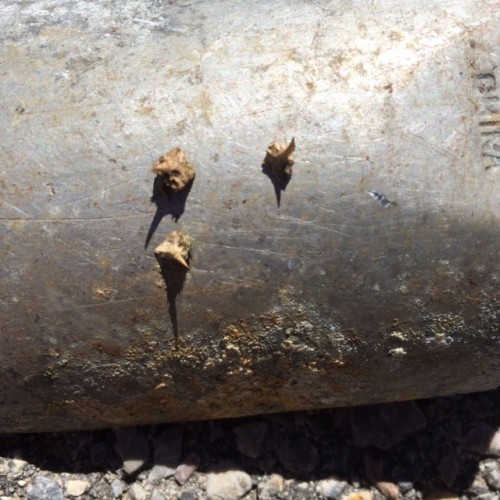
By Tom Jow
The month of September brings out some of the best things for cycling. Cooler temperatures, fall colors and the occasional dust tamping rain to name a few. It also brings out one of the worst: goathead thorns. If you use anything with a small pneumatic tire such as bicycle, wheelbarrow, or baby stroller, you have probably suffered a puncture by them. If not, you will. These thorny pods (that look like a goats head ) are the seeds for a low growing weed named Tribulus terrestris. This plant exists in warm climates all over the world, including the desert southwest and Utah. In and around Salt Lake City, they are found all over the foothill trails, vacant lots, sidewalk cracks, the Jordan River Parkway and Antelope Island.
Fall season is when they are at their peak, bringing several clients each day with punctures to our shop alone. How is this thorny pod so effective at puncturing tires? The reason is evolution. The seed pod is shaped so that however it lays on the ground there is always a sharp spike sticking up, waiting to attach itself and be transported to a new area. The spikes are up to six millimeters long, guaranteeing it will puncture any small, thin tire. The pods may lay dormant (without germinating) for more than three years, assuring a plentiful supply. There are, fortunately, preventative measures that can be applied to reduce the chances of getting a puncture after rolling over these pokey things.
The current standard of protection is to use inner tubes with a sealant in them. This sealant is a thick green liquid that can be installed in any schrader valved tube and will seal most punctures. Inner tubes can also be purchased that have the sealant pre-installed. While being a little on the heavy side, this type of sealant is a great solution for any bike, wheelbarrow, baby jogger or stroller.
For performance oriented riders there are lighter weight sealants that are latex based. Designed for tubeless tires, these lighter weight latex sealants can also be used in inner tubes. They are a a great solution for any cyclist seeking light weight puncture protection. Cyclocross racers in particular will benefit as many of the Utah cyclocross courses have ample amounts of goatheads. Their main drawback is they can dry out and lose effectiveness and therefore require monitoring for continuous protection.
In addition to sealants, riders can also consider a barrier method of protection. Many tire manufacturers are building heavy duty models with puncture resistant linings within the casing. Also, plastic tire liners are still available, however they are heavy, difficult to install, and have been known to pinch the tube from the inside.
Having a flat tire while out riding can put a damper on anyone’s day if not prepared. Any one of these products by itself will protect your tires from punctures. Combine a barrier with a sealant and you will be nearly invincible. Unfortunately, no combination of tire protection products can prevent all punctures so always carry a pump, spare tube and tire levers just in case.
Got a bike question? Email Tom at [email protected].


[…] Tips on dealing with goat heads and cycling: https://www.cyclingwest.com/tech/fall-is-the-best-time-for-cycling-and-goatheads/ […]